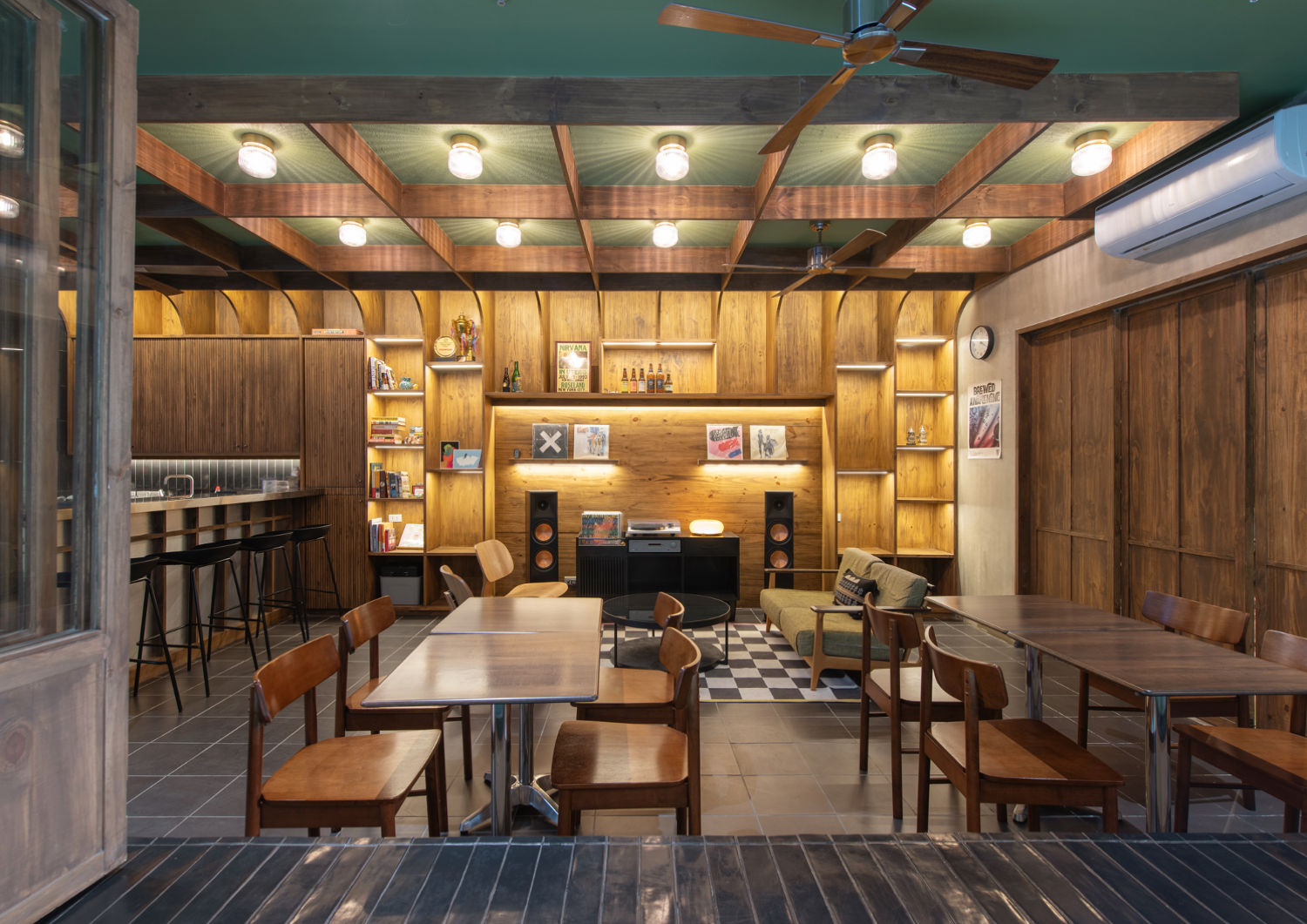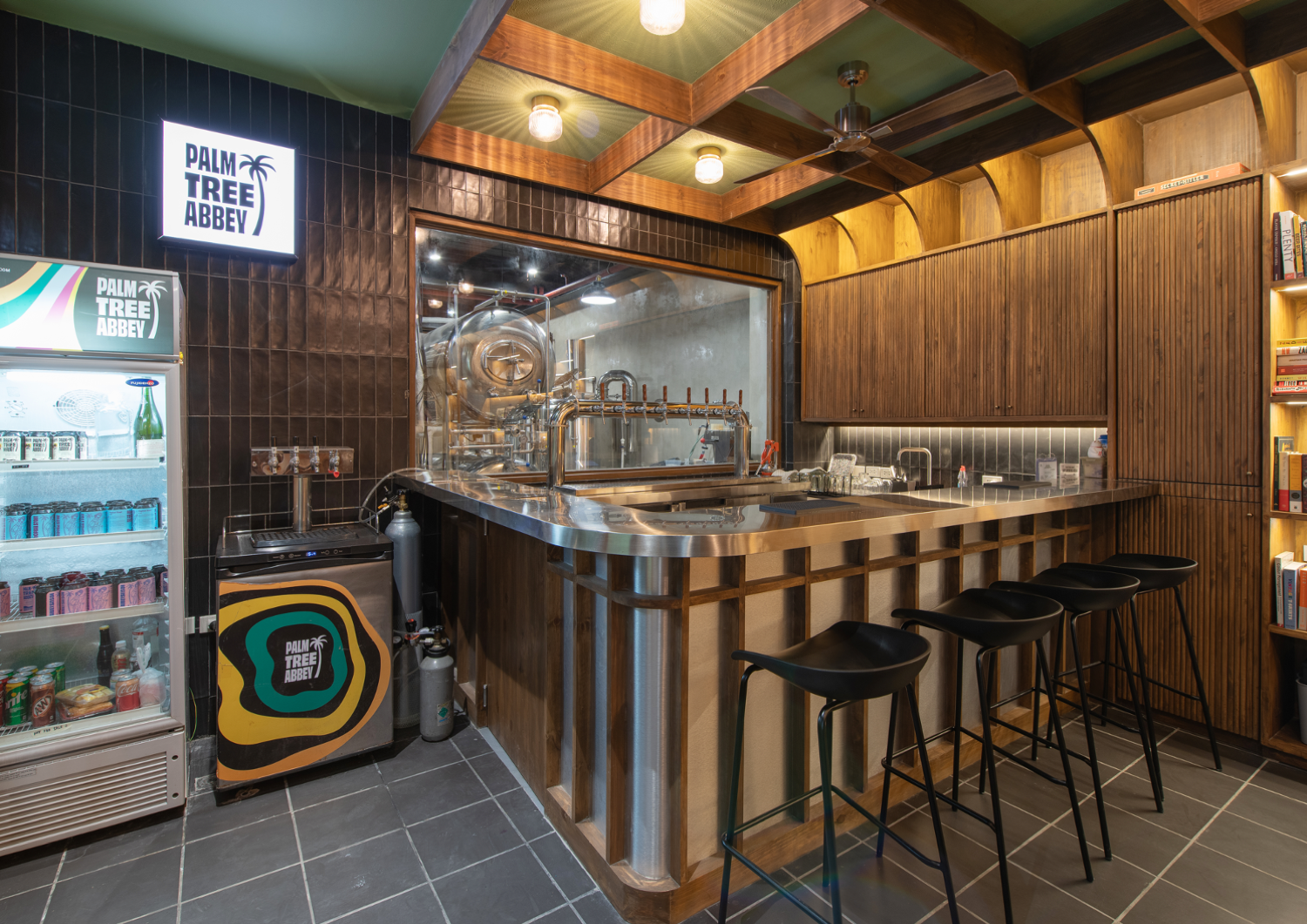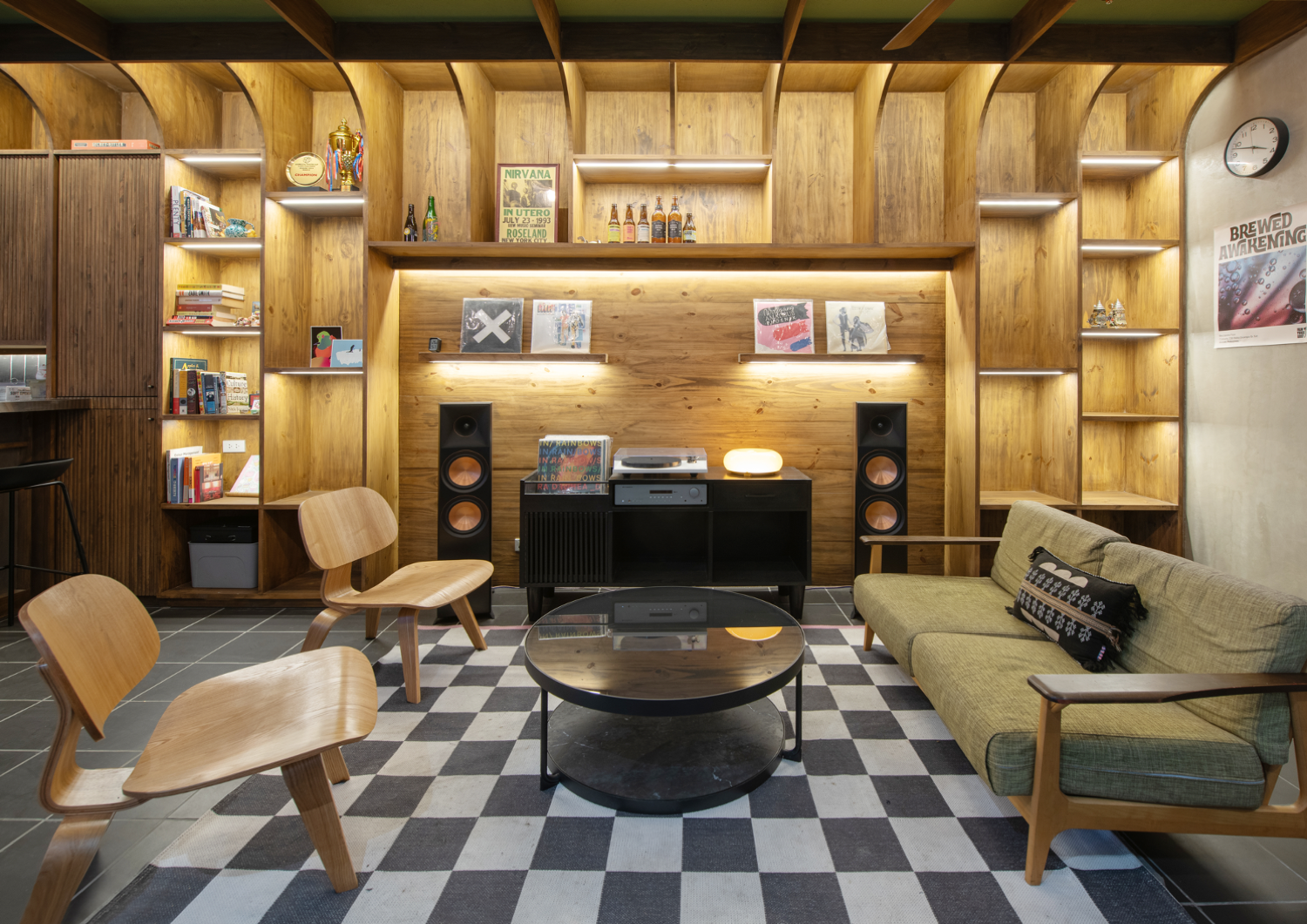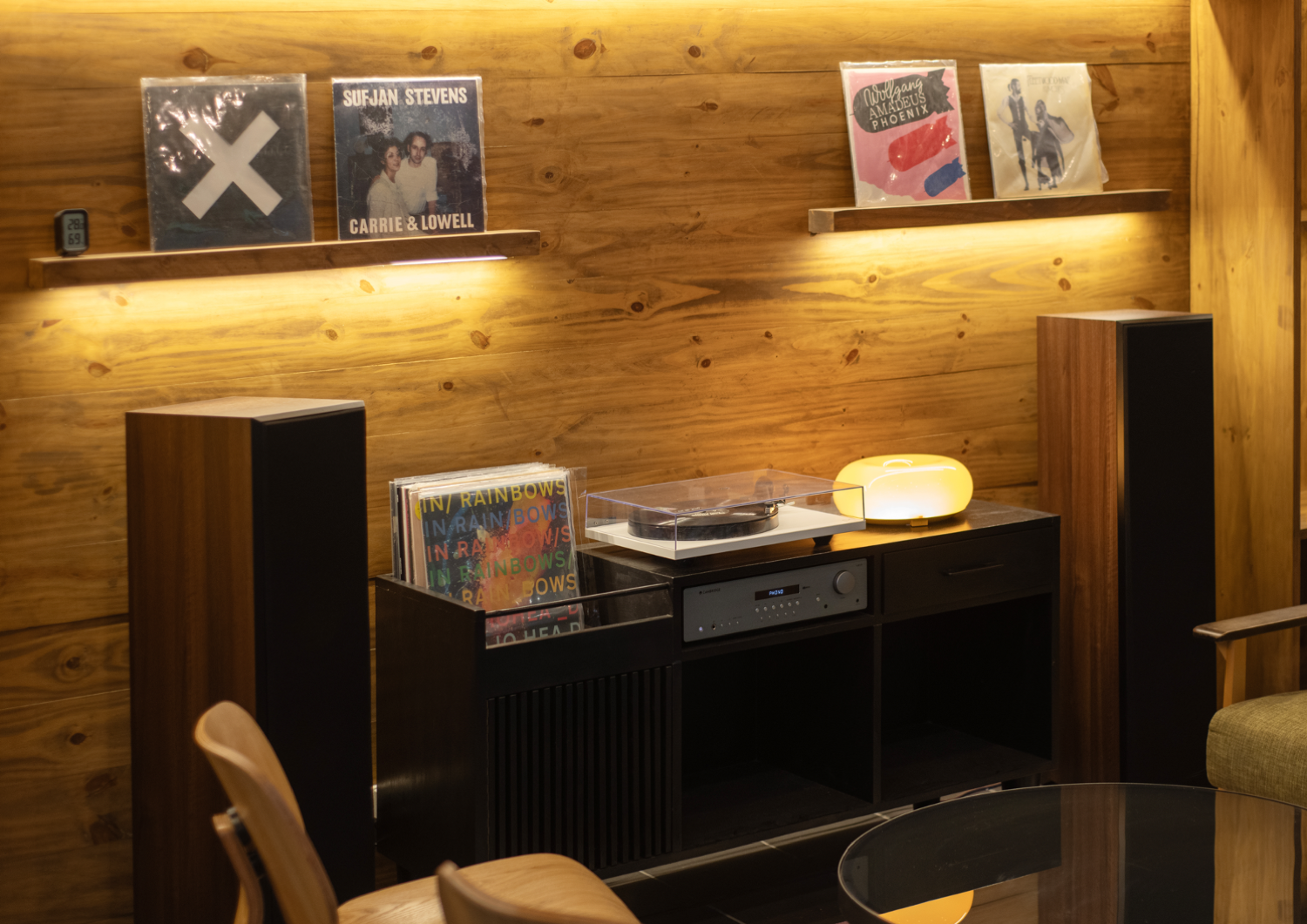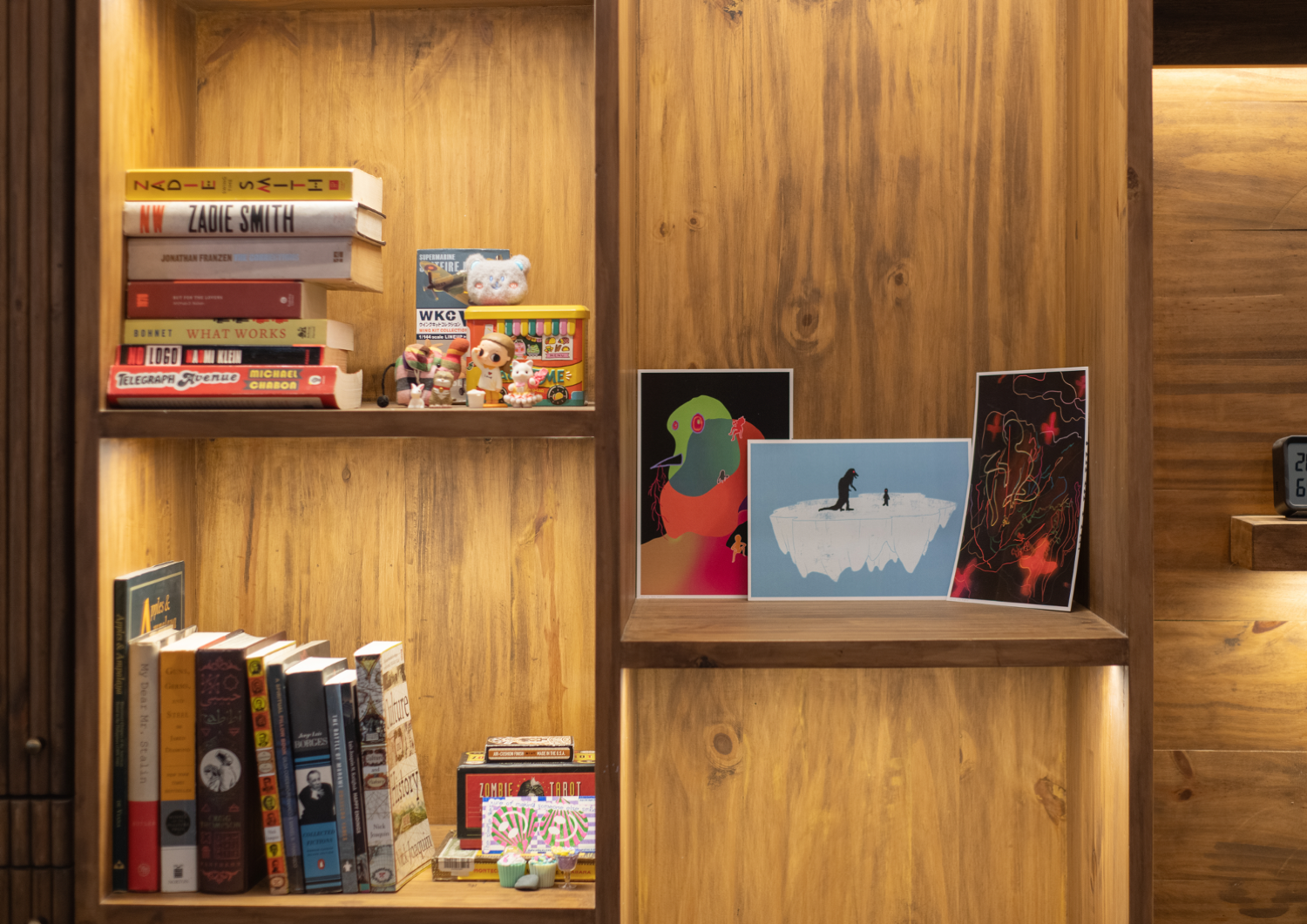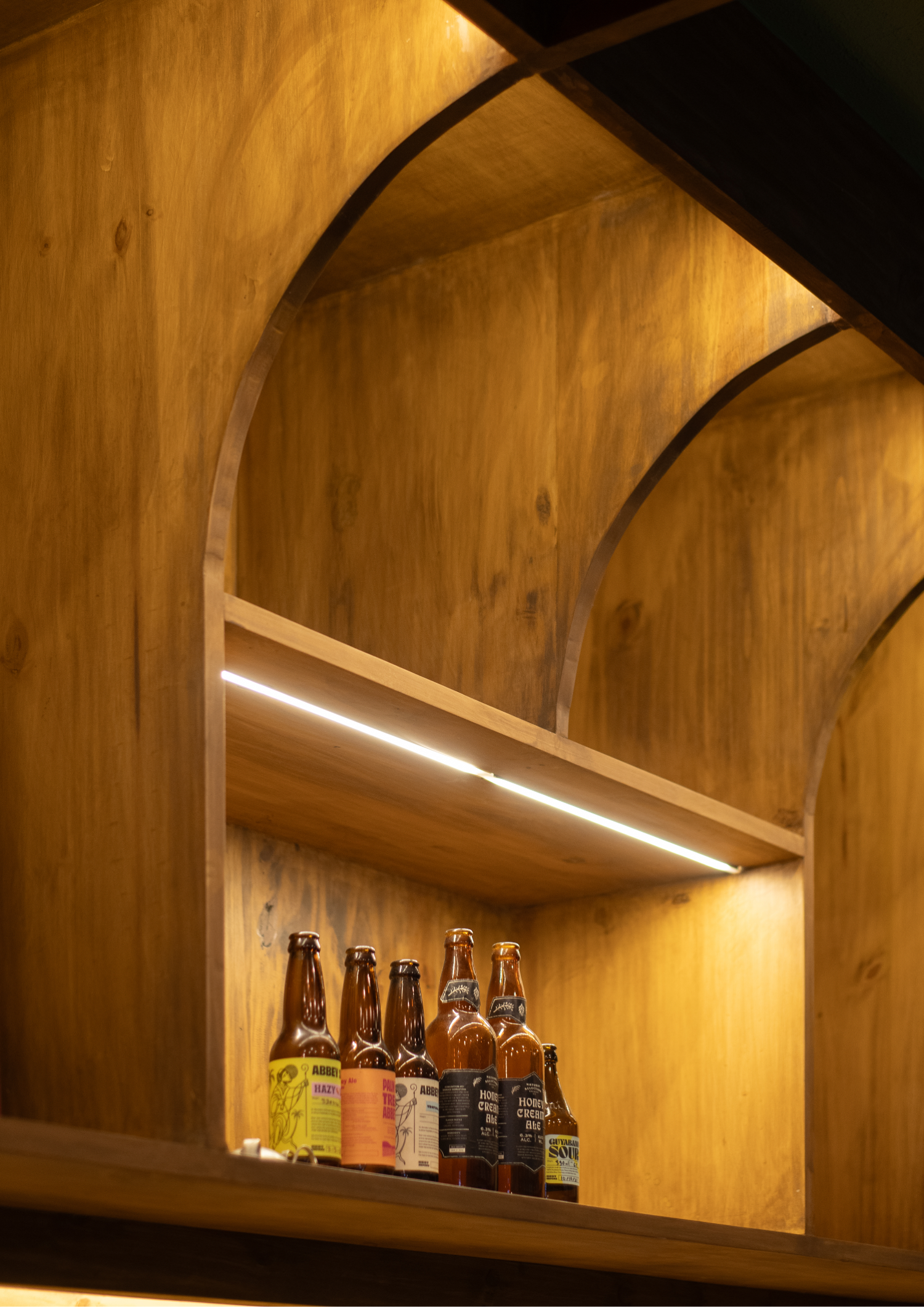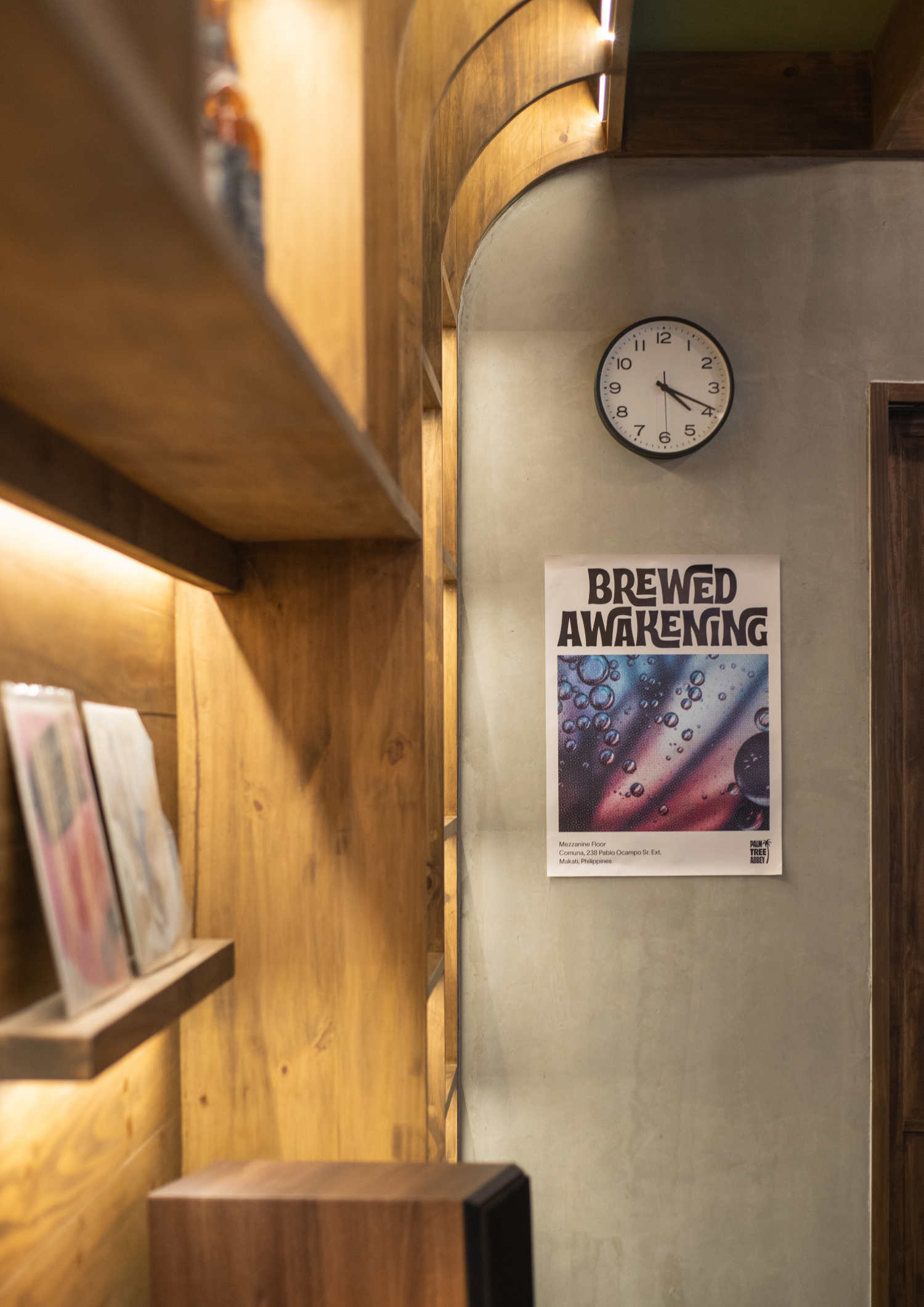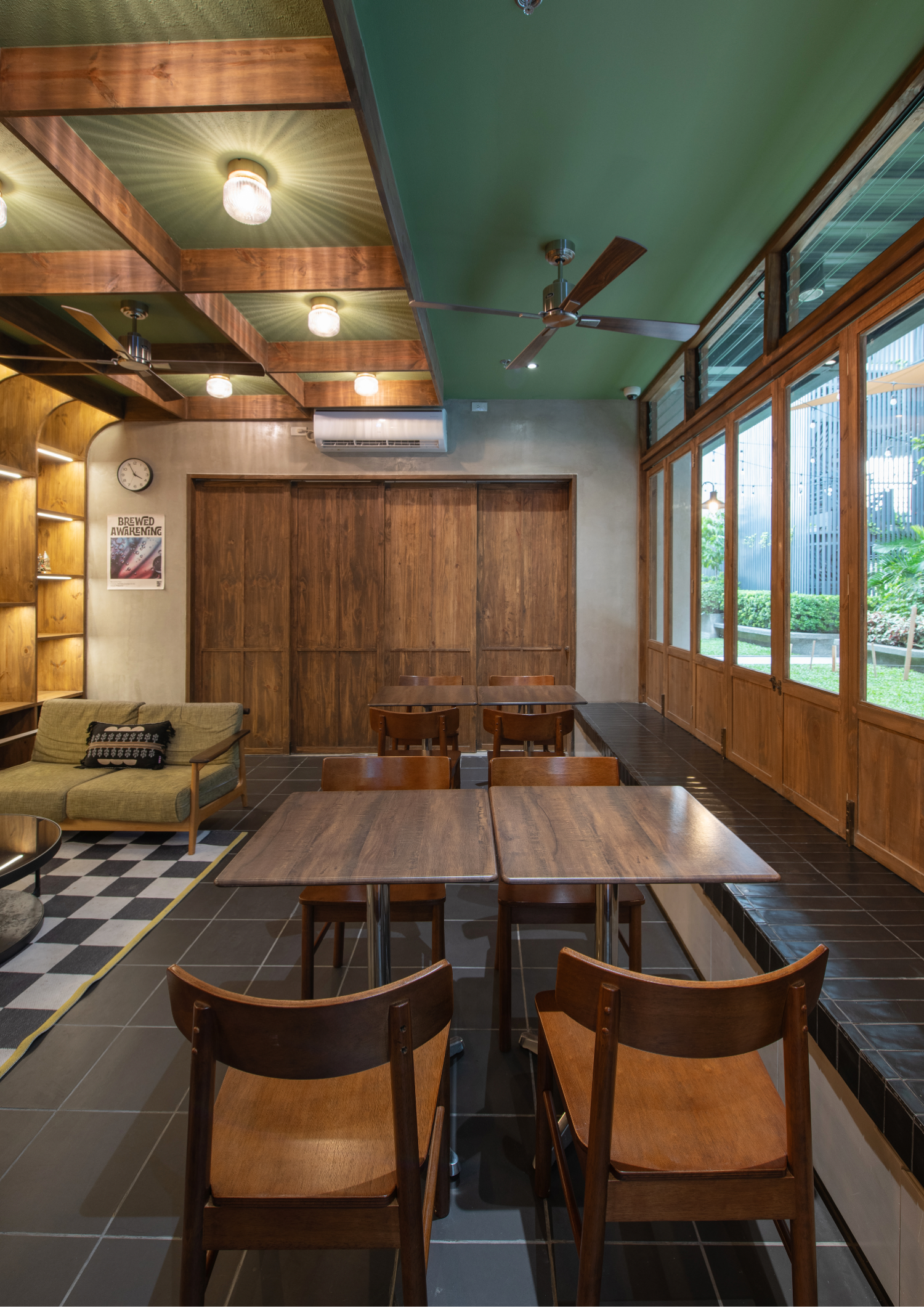Words Gabrielle de la Cruz
Images Greg Mayo (Palm Tree Abbey)
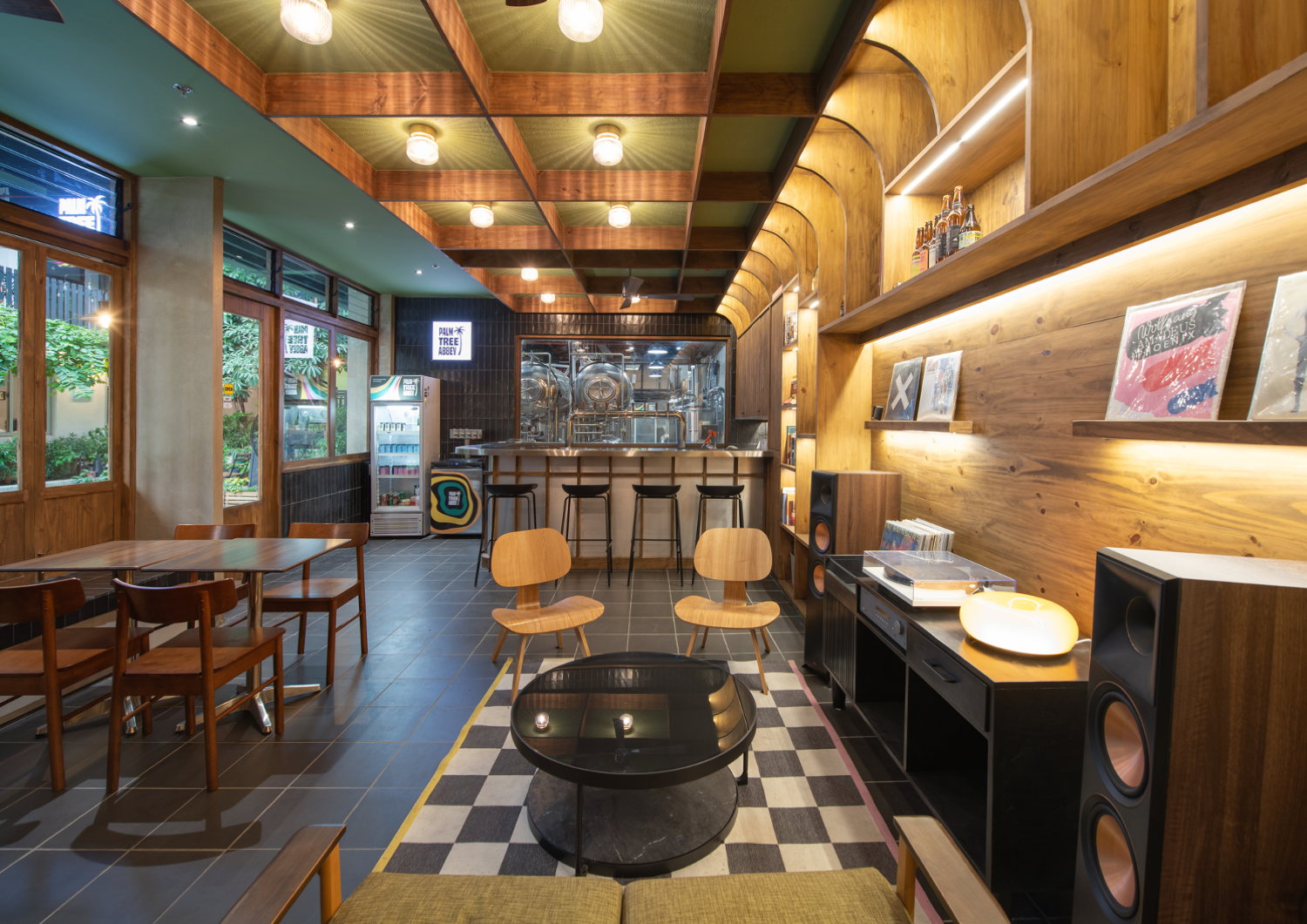

A living room setup is not exactly the first thing that comes to mind when envisioning a pub or brewery, but that’s precisely why it was the choice of owners and beer enthusiasts Joel and Marla Darwin for craft beer brand Palm Tree Abbey’s first Philippine outpost. “Before we had this space, we spent years in a Kapitolyo garage. So, our dream and yearning centered on the opposite: fresh air, natural light, greenery,” Marla recalls, to which Joel added: “Hopping through breweries in the US was a remarkable experience for me. There, people could drink beer and relax, with the spaces designed to accommodate families, have kids play, and individuals get to have actual conversations and listen to one another. I was worried. It was a shot in the dark. How do we make that happen in Manila?”
The owners found a fit in a ground-floor unit at Makati’s creative hub Comuna, a space that sits right next to a small garden. Design-wise, they found a match in Commonsense Studio headed by architects Arisa Jarque and Raisa Vargas, whose “purposeful design” for retail experiences resonated with them. Initially, the plan involved a single unit, but it was later decided that two would best address the spatial needs of a brewery and taproom.
“When Marla and Joel came to us to design, their brief was simple: a space far from the typical brewery you would go to for a night out. A place you can go to even on a lazy afternoon. Our response was also simple: to design something nostalgic of a living room, to create a space that feels like home,” Commonsense shares. Facing both units, the brewery is positioned on the left side, with cold, massive metal cans used for production. The steel bar area inside the taproom acts as a transition from the cool tone of the brewery, with the lounge area warmed up with the use of materials such as wood, soft tones, and bright hues.
First Pour
Nice to meet you, Joel and Marla! I’ve read that Palm Tree Abbey, as a brand, was established in 2016 by Canadians Jonathan Heppner and his brother-in-law Evan Graff, who are beer drinkers involved in ministry and non-profit work. Can you tell us more about how you got involved?
Joel: When Jonathan and Evan started to look for craft beer options here in the Philippines, they found that there wasn’t much, so they decided to start homebrewing. That’s the space where we all met. They invited me to join in 2020 and help them out in terms of the business structure, as my wife and I run a design studio call NS Design. They wanted me to help out with the books and turn this into a profitable venture.
Jonathan already moved to Lesbos, Greece with his wife and works at an NGO that provides livelihoods to refugees coming from Africa. He is currently working on a farm and a sustainable brewery and is more of a symbolic partner now. Evan, on the other hand, is also here in Manila and is currently a high school teacher. He and his wife run an orphanage in Cubao.
Since we took over, we have slowly scaled up the brand. We worked on production and sales. As we also run a branding studio called NS Design, we took care of the labels, packaging, and created an entire identity for Palm Tree Abbey.
Marla: It happened at a very interesting time, which was during the pandemic. We experimented with the business model, which is direct-to-consumer. We brewed out of our space in Kapitolyo, people would place their orders online, and then we would send them off by a rider. We didn’t get to interact with our customers as it was a time of very hard lockdowns. But we realized that people were still drinking! I think a lot of people who enjoyed our beers during that time are still our fans now, and in fact, we’re some of the very first people who came here when we opened it.
Joel: The space you see now is the product of several years of slowly scaling up and dreaming and scraping together some funds.


Out of curiosity, can you tell me where your love of brewing or beer drinking comes from?
Marla: We just love it, and I recall we met through beer! In college, we drank a lot of beer, and plenty of my happiest memories of gathering with people (and even my first dates with Joel) involved drinking beer in a space.
Joel: I’d like to think mine is born out of my frustration to be a scientist or tinker. I like to work with my hands, and brewing was a good way for me to get into something. The process is very straightforward, but there are a lot of variables that we need to stay on top of. There are always new challenges and discoveries that keep me interested in the craft of brewing. It’s a reward because it takes time, so there’s a lot of patience involved.
When you brew, you have to let it ferment for around three weeks, and that’s even before you can check if it works out or if it’s hitting the numbers you want. There’s a certain slowness to it that is appealing to me.
Would you say that waiting is your favorite part of the brewing process? Or is there a particular step you most look forward to?
Joel: I like to call it a ritual because it’s been around for thousands of years. We’re partaking in an activity that has been with us since mankind evolved, right? Part of the experience of brewing a beer is that you have to drink while you do it. Homebrewers believe that it’s bad luck to not drink a couple of beers when you’re brewing!
It’s a time for us to pause, block off a couple of hours of a busy day, sit down, intentionally, work through the process, and also gather and hang out. That’s what I enjoy the most.
Marla: With the process, there’s always going to be a flurry of movement and then an hour of waiting before you get to proceed to the next step. And then you move again, then wait again. I like how Joel pointed out that it’s a ritual because it also teaches you discipline. But as mentioned, it’s also a great way to just destress and unplug because we have day jobs.
Joel: It’s shifted gears a bit since we turned it into an F&B spot as we don’t have as much time and luxury. But it still delivers on that feeling of getting to pause every time I get the chance to do it. It gives you the privilege of simply creating something.


I feel like it’s poetic in the sense that brewing beer takes a lot of waiting, and you said that this space also took a lot of time before it came to fruition. Can you walk me through the thought process behind setting up a physical space? How did you know it was the right time to transition into a full F&B concept?
Marla: That’s a good question. There was a time when we had ideas for a physical space as we felt like we were hitting a wall already. We knew that we couldn’t sustain brewing out of the Kapitolyo garage. The numbers weren’t making sense anymore, we were getting very tired, and we knew that if we did not scale, all of this would be over. At that time, we didn’t know what form the new space was going to take until we saw Comuna. We knew we had to move; we had to evolve, but so much of it was luck.
When Comuna was looking for tenants to fill the space, builder and community manager Maya Katigbak Colayco told Dan Matutina, who helped bring people here, that she wanted to have a place for beer. Dan thought of Palm Tree Abbey and immediately reached out to us. It’s funny because our friend Sonny, who is a photographer, initially told us about Comuna for NS Design. But we said we’re happy with our current space at Pioneer and thought we weren’t ready to make a big move. So, when Dan reached out about the brewery, there was just this tingly feeling that we should take it.
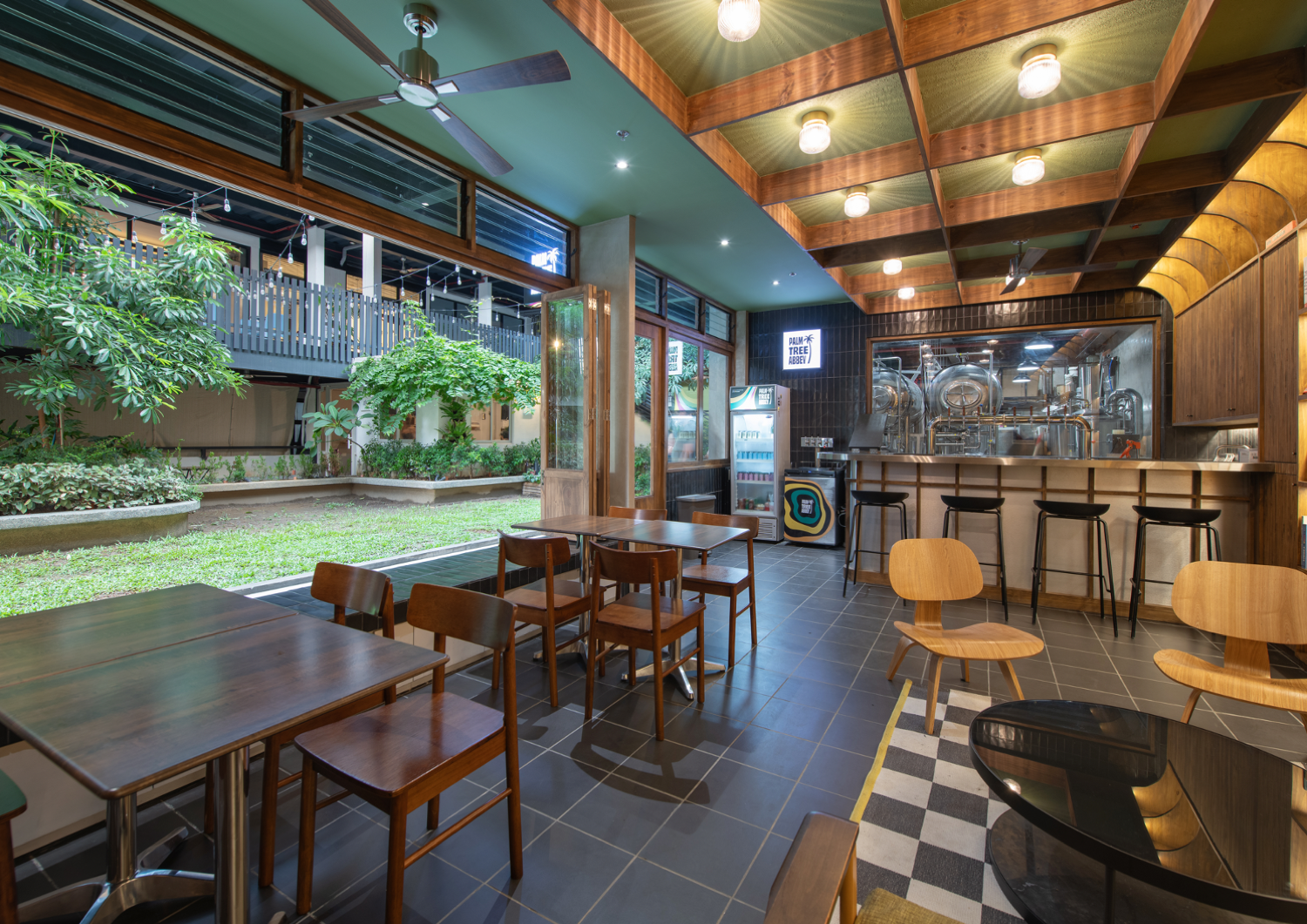

Tapping in
I’d like to get into your relationship with Commonsense Studio. How were you introduced to their practice?
Marla: Having Commonsense design this space was entirely my decision. I just informed Joel that it’s going to be them. He had no choice. I just knew it had to be them. I knew of their practice through Raisa, as we went to the same high school.
We also did some design work for Bucky’s, a pastry business by Raisa and her husband. I was a big fan of their previous space in Poblacion, Makati. I just pigeonholed that moment of me saying that when the time comes that we can have our own space, I want it to feel like that. I remember how it was Japanese-inspired, formed by objects from travels. But it didn’t feel forced or a copy of another space. It was its own.
I’m not a fan of places that feel like theme parks, and by following Commonsense through the years, I’ve always felt like their designs are purposeful. You can see from the get-go that they make their design decisions based on what the space demands and what fits it.
I also feel like there’s something about their designs that feel very Filipino—not because of the forms or materials but mainly because the spaces carry that maaliwalas feeling. It’s very important to me because it’s one of the things that you will only notice once you actually see and feel it.
Take us on a retrospective of the design process. What were the first steps you took upon working together? What were some of the non-negotiables?
Commonsense Studio: When we design a retail space, it is automatic for us to ask for a brand guide, as we intend to highlight what the brand is all about. Since Palm Tree Abbey has established its characteristics already, it was not hard for us to deliver on Joel and Marla’s requests. They knew what they wanted and needed, so the living room design came to us easily.
Marla: We didn’t want to be the type of clients who would say: we trust you completely, then later scrap every idea presented to us. Most of our requests centered on certain materials, like the checkerboard tiles you see here. These are reminiscent of the tiles in a commissary in a friend’s house in Quezon City, which hosted Palm Tree Abbey before we moved to Kapitolyo. Little things like this remind us of our origins, and it’s important for us that the space holds them.
Speaking of highlighting the brand, one of the things that make Palm Tree Abbey recognizable (at least for me) is the distinct, colorful packaging you designed. Was this influential to the space’s design at any point?
Marla: Thank you for saying that! The branding is very loud, and I had a feeling that we would also be attracting very colorful characters. I wanted the space to complement and balance that instead of fighting it. The placement of shelves to display the bottles and other fun items was a good move, as it gives patrons other things to look at aside from the space itself.
“A listening bar was one of the non-negotiables of the client, and it eventually became the starting point of the design,” shares Jarque of Commonsense. “I feel like aside from the bar and bench of the space, this has also become one of the statement areas of the space.”
I like how the space is small yet boasts subtle material, texture, and pattern contrasts such as the steel bar against the wooden shelves, or the mismatched furniture set against a checkered floor mat. Can you tell us more about your thought process and criteria for selecting materials, finishes, and even furniture?
Commonsense Studio: We kept the material palette to a minimum to allow for flexibility with the space in case the clients wanted to add the brand’s touches. The wood was selected for its warmth, and the stainless steel to reference the industrial nature of breweries. We knew that selecting all the pieces had to be more intentional. It was a lot of back and forth but we also trusted that the client had good taste since ultimately they had the final say.
Joel: I recall Commonsense giving us a list of recommendations we can use for furniture shopping as well, and how we would consult with them for every purchase. I think what they were able to achieve here is the natural transition from the equipment from the tap, which is cool, to a warmer, more welcoming space.
“We put acoustic boards on the ceiling to absorb sound and made sure to use real pine wood for the shelving unit,” Commonsense shares. “The upholstered furniture and checkered rug also assist with the acoustics, along with the operable windows and doors.”
What would you say are your favorite parts of the space?
Commonsense Studio: For us, it would have to be the bar. It was the last design decision we made and we had to change the design and material towards the end, but we are happy we did. The stainless steel counter and base bridge the brewery and bar seamlessly.
Marla: I’m a functional extrovert. I can face people, be up on stage, and all that. But when it comes to recharging, I need my own space. I love how we have spots here in the room where I can do that. I could stay in a corner and read or just drink, or simply relax and observe everyone.
Joel: I like being behind the bench. Because I love the green space, I like how the bench opens to it. This space is also where people can sit back-to-back, talk amongst themselves, and breathe in the views. Whenever there is heavy traffic at Comuna, I’d like to believe that this is one of the spots where you’ll find the concentration of people.
Marla: We like to say that the bench feels like a college free cut! It’s reminiscent of that thought we have about healing our inner child. Once you experience it, you’ll get what we mean!
Can you share any memorable anecdotes from people who have experienced the space? What’s the verdict so far?
Commonsense Studio: People we know were surprised to find out that we designed the space, which to us is positive feedback! We’re happy that this bar and brewery speaks about us in a way that our design principles are also seen in spaces like this and not just residential projects, that our female-led design studio can create a bar/brewery that tends to be perceived as masculine.
Joel: One time, Den Ocampo, a content creator, came here. I recall her sitting at the bar alone and enjoying her drink, and at that time I didn’t know it was her! She created a post on us, and people initially thought we were a cafe. That’s not bad at all, because that means we were able to deliver on the warm atmosphere we’ve always envisioned for the space.
Marla: We find that there are similarities between third-wave coffee and craft beer: creating community hubs and finding spaces where people can gather. At the heart of it is that it’s ours is a pub where people can bring their families and feel safe, which is far from the usual ones we have here in the Philippines. To be able to deliver this kind of experience means a lot to us because the dream has always been about bringing people together.
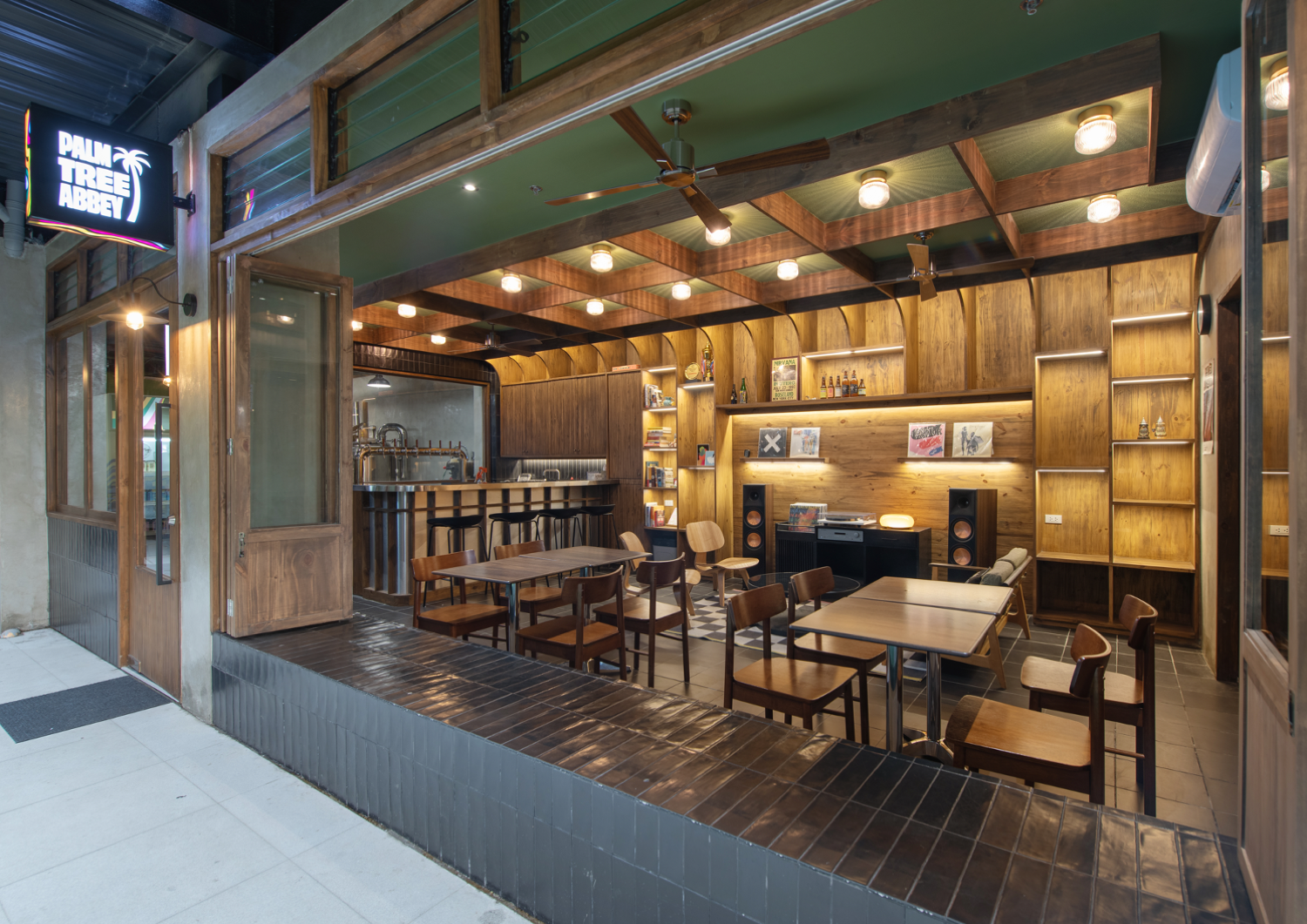
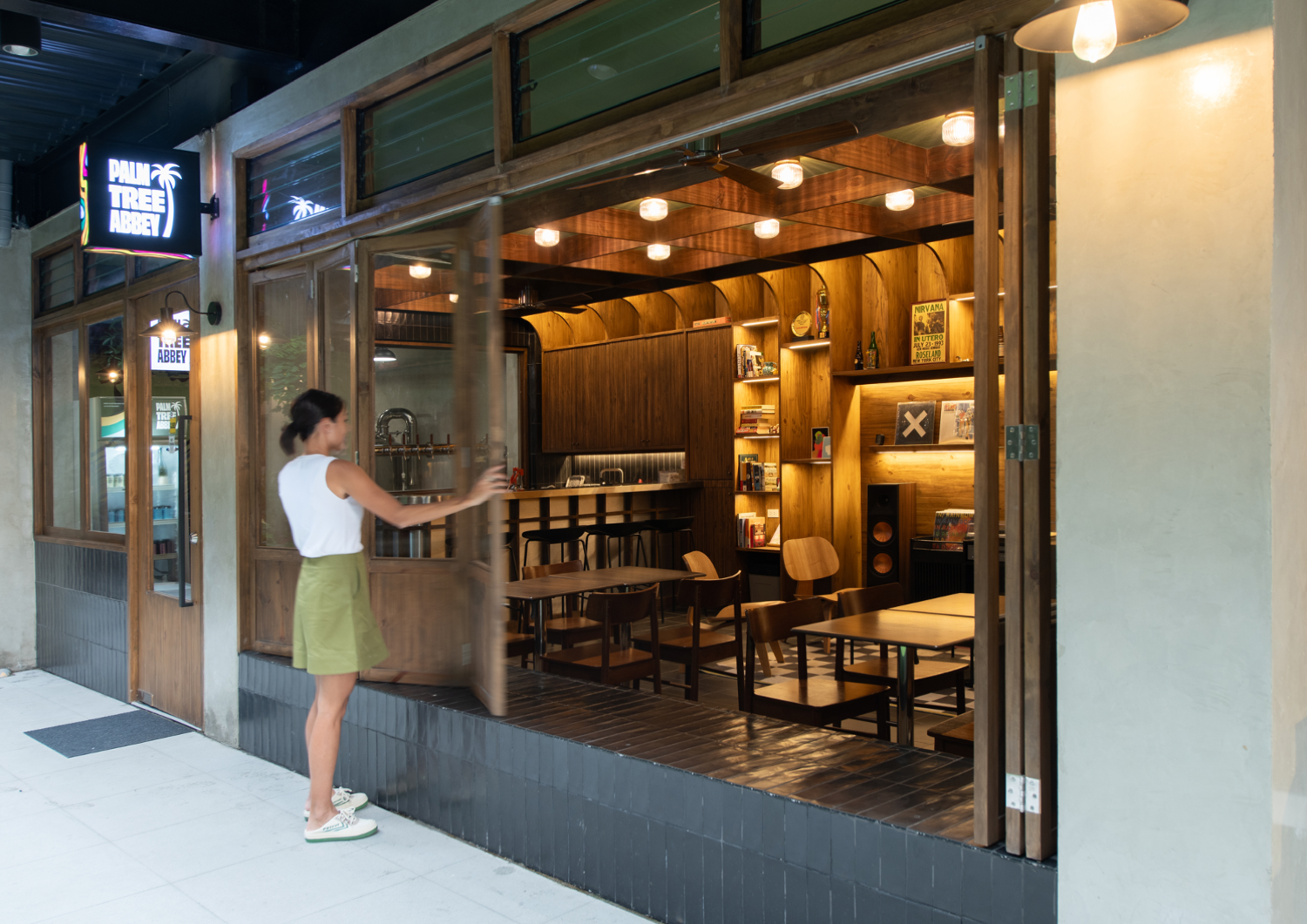
Familial and Familiar
We’re nearing the end of this interview, so I would like to ask Commonsense about their experience. What do you think makes Palm Tree Abbey different from all the other retail spaces you’ve worked on? How does the design you’ve created here speak of your evolution as a studio?
Arisa Jarque, Commonsense Studio: We always approach design by thinking that we are the end users. I think it is very important to fully immerse ourselves into the space and see how we would like to experience it ourselves while integrating the client’s wish list.
It’s always a balance and I feel like since we started the studio in 2017, this has helped us grow as a studio and nourish and appreciate the relationships we’ve built with clients. Designing something for someone is a personal experience, and we’re so lucky that most of our clients come back to us with other projects to work on or refer us to their friends and families.
We care about our clients and like many others, we want to make them happy. This goes beyond creating a unique concept that will make us stand out from the others. While Palm Tree Abbey is far from what people usually perceive our work to be, it’s the experience we were able to create for Joel and Marla and the patrons who will visit here that matters. As a studio, we’ve grown to accept that the challenge is not just designing unique spaces, it’s satisfying senses and building relationships with people.
Joel and Marla, congratulations on slowly building a community here. Are there any further goals or dreams for the brand?
Marla: Right now, we’re at the stage where we’re trying to meet supply and demand and deal with technical aspects of the business. That’s a lot of work. A lot of our plans involve things we want to have that we can’t find anywhere else—events that would bring the space new life. We want to work out artist collaborations where we partner with illustrators and designers and they design limited offerings for us. This can include launch parties and brewing a special batch for the event.
We also want to have supper clubs. We’ve recently talked to an oyster company that popped up in Space63, and we befriended them and said we want to start doing oyster nights here.
Joel: Long-term, we don’t think that we would be building something bigger than this space. One of our wildest dreams is that our friends in other countries would appreciate what we are doing here and maybe want to start something of their own because of it. It’s another shot in the dark. But who knows?
One of the reasons why we built this space is because some of our closest friends and loved ones only come here during the holidays, and we want to let them know that something like this exists. At the same time, it’s also an assurance for us when we’re away. We get to leave a part of us at home, and it’s a place we can always go back to.
Marla: What I like about this space is that it offers subtle hints of nostalgia. We’ve had friends tell us that the space feels very Filipino because of the classroom-like windows and other aspects, and that’s an achievement! There’s that sense of familiarity that delivers on everyone’s collective consciousness of what Philippine spaces feel like.
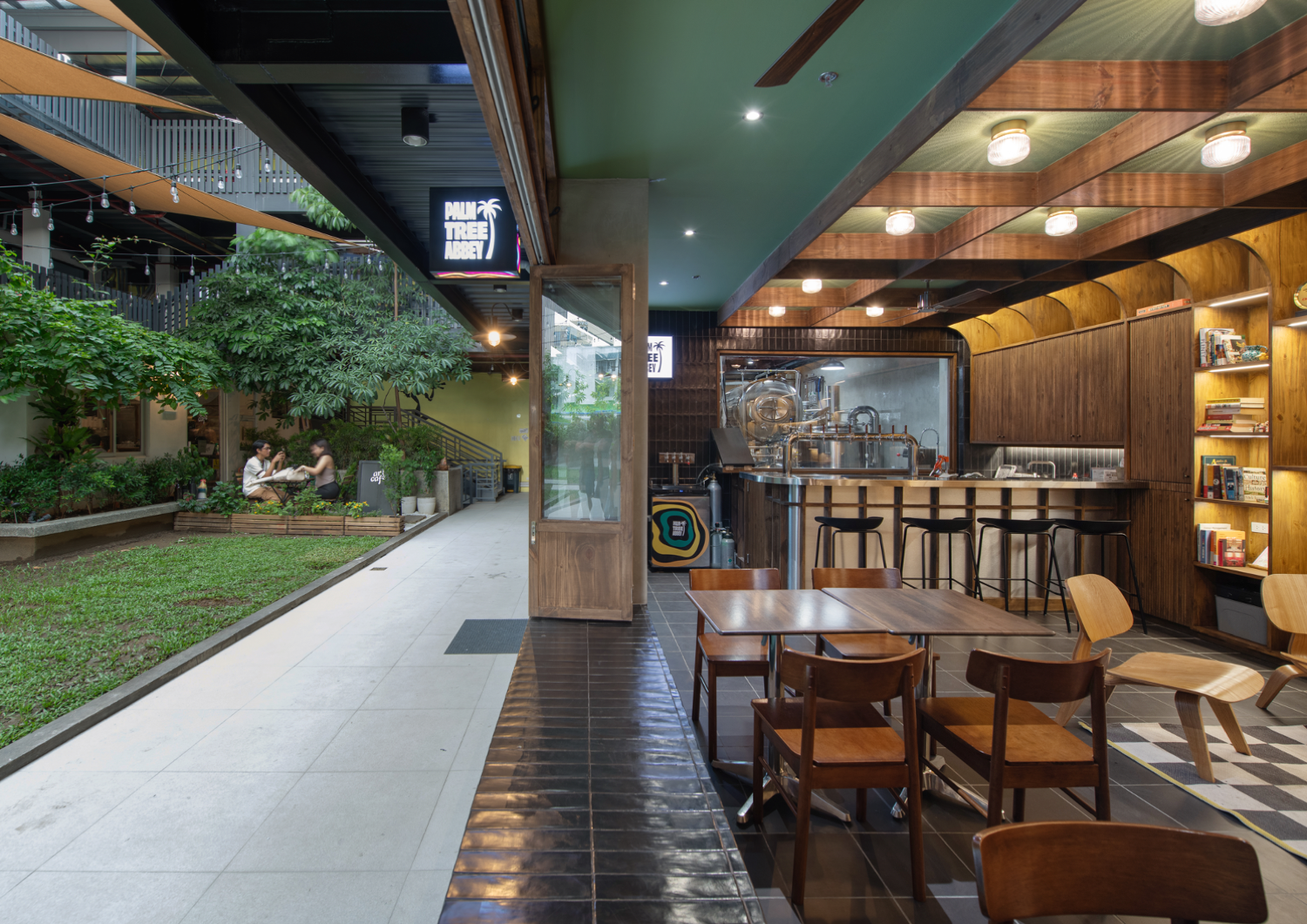

Lastly, if you could have one person, living or dead, walk into this space, who would it be? What drink would you have with them?
Marla: I have a very sappy answer for this. We’re friends with another couple who made really delicious buns and ramen. When we were building this out, I told them that as soon as they got back here, I wanted to serve their food here in our kitchen. In fact, they were the only people I wanted to work with in terms of food at that time.
When they got back, Jake was unfortunately diagnosed with cancer. He passed away last year. We feel like he has always been a part of this, and if we, or this space, had the power to bring him back, we would.
Joel: Jake and I are about the same age, and I used to drink with him in college as we were neighbors. He’s one of those friends who, even if you go through life apart and run around different circles, you sort of find your way back to each other.
I’d love to brew a pale ale with him again. I remember the one we had was made with galaxy hops, an Australian hop that is citrus and straightforward. We filled up maybe 15 bottles and when we tried it together, we were like kids saying “Hey, we made that!”
I know that he would have loved this space. And it’s the memories of people like him, and the moments we are yet to build, that will always make Palm Tree Abbey feel like home. •
